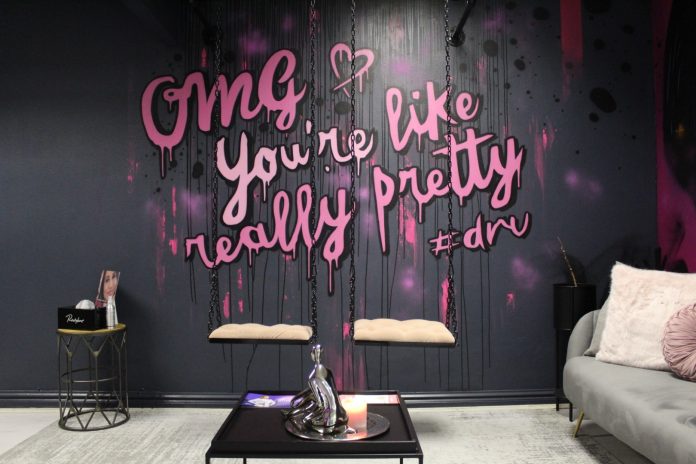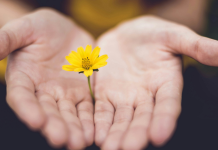Once upon a time, we found ourselves facing the point of a sharp needled attached to a syringe. It’s contents … blood! Read on to discover how the vampire facial ended for our needle-phobic Get It journalist.
You’ve probably heard about it before or seen photos on Instagram of celebrities or beauty content creators’ faces seemingly smeared in blood, but the popularity of vampire facials or platelet-rich plasma (PRP) therapy has yet to die down – and for good reason!
These no-knife facelifts are said to help boost collagen production for tighter, smoother, newer-looking skin, and improve everything from hyperpigmentation to acne scars. So, it was time for Bronwyn Forbes-Hardinge to put these claims to the test.
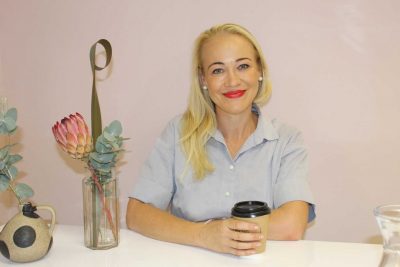
The vampire facial is a very contentious treatment in the world of facial aesthetics, as qualified medical aesthetics doctor Gwen Evans explains. Basically, a mask made out of a component of your own blood – not anyone else’s – spread over your face to rejuvenate your complexion. It boasts impressive, almost painless results that will give you the most glowing skin of your life.
How it works? Dr Gwen, who has been practising aesthetic treatments for well over a decade and specialises in PRP therapy for both face and hair, explains the technique ….an extraction of my own blood and a whole lot of needle pricks to the one part of my body that is probably the most delicate, my face, not to mention the most visible to the rest of the world.
As terrifying as the procedure sounded (especially if you’re needle-phobic), I signed the consent form, somewhat apprehensive, and tried to focus on the relaxing atmosphere and harmonious surroundings of the room, certainly not your average looking doctor’s room!


The actual procedure …a topical anaesthetic was applied to my face; a vial of blood was drawn from my arm (about 30cc), much like a blood sample taken at a lab, and then placed into a centrifuge machine which spins the blood to separate it from the platelet rich plasma (also known as liquid gold). The PRP was then drawn up into syringes and injected back into my face and neck targeting areas of concern.
Through micro needling Dr Gwen then created tiny channels in my skin to increase the penetration of PRP for ultimate results. The best part of this treatment is that it’s all you, no harsh chemicals, no added ingredients, just your own platelets waiting to work their magic on your skin.
“PRP is known for its regenerative and rejuvenating properties. It activates a series of growth factors in your skin, that can heal and rejuvenate damaged skin, improve hyperpigmentation from sun damage, help with under eye rejuvenation, heal scars from acne or other injures, improve pore appearance, improve overall aging of your skin and most importantly induce collagen to help combat fine lines and wrinkles associated with aging.”
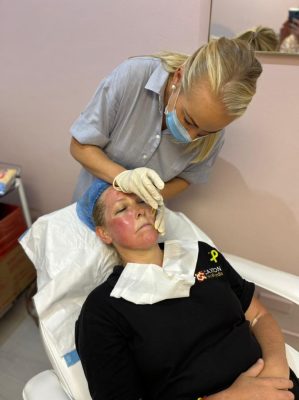
The whole procedure takes about an hour and if you can handle getting a tattoo, which I am used to, the pain should be minimal if anything. It certainly was nothing to squeal about for me, although Dr Gwen says it all depends on YOU, which I can well believe.
The down time is usually two days, meaning your face will feel a little inflamed and sun burnt. Initially I felt as if I could bury my head in a slush puppy or three. It also doesn’t help that you aren’t allowed to wash your face at all, until the next day … but it is all part of the ‘vampire’ experience.
The burning sensation did not last long and the little tub of medical cream I was sent home with, to gently apply over my face and neck an hour or two after treatment, was a sanity saver! Especially as I CAN …. NOT deal with a dry, tight feeling on my face.
Dr Gwen says, “depending on your skin type and sensitivity you can experience tenderness, bleeding, bruising, and you’ll definitely have some pinkness/redness of the skin. But this is temporary, and you can always apply an ice pack as needed. It’s important to keep hydrated and wear an SPF post procedure.”
She also advises not to undertake any heavy physical activity during your downtime. I recommend a Friday afternoon treatment followed by a weekend of reading and going nowhere. A long overdue visit from a special friend, coupled with some lunch, a leisurely walk and some tea and cake helped distract me from any discomfort.
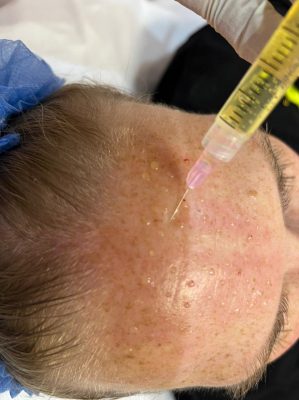
“Collagen stimulation happens over the course of six months to a year after a procedure like this. The first few days after your treatment, keep it simple. You’ve just created wounds that need to heal, so any harsh ingredients like exfoliating acids are a definite no.”
For the first 48 hours, Dr. Gwen recommends sticking with the medical moisturiser and a thin layer of Vaseline or tissue oil on top, if your skin feels a little extra dry. Or, try a try a fragrance-free moisturiser, and keep your skin makeup-free.
“The number-one thing you should not do is go out in the sun. Because vampire facials compromise the top layer of your skin, you don’t have as much protection from the sun, so you need to be really cautious and avoid exposure as best you can during the initial healing period.”
About two days after the initial 48 hours, I saw a difference in the tone and texture of my skin – brighter and more refreshed – and I went to work wearing only mascara. Believe it or not, the compliments already started rolling in.
After the first week the filler effects began to take place. I was told that noticeable improvements would slowly build over a month as the filler settles in and my body produces collagen from its growth factors.
By the second week, after gentle exfoliating every other day, my skin was feeling less dry and more supple, with a firmer tone. Visibly, it was a lot smoother with a really healthy glow.
Come the third week things got even better and the compliments kept coming! Dr Gwen says it takes about 30 days for the new collagen to regenerate itself and for your skin to really revitalize itself, and about three months to see maximized results.
At the time of going to print, I was at the four-week mark and there has been a remarkable improvement in my skin tone. Some fine red capillaries and redness on around my cheekbone area, is hardly even noticeable now and my skin is looking a lot healthier and smoother – plus I’m loving the lighter feeling of not wearing make-up, something I’ve, thanks to new-found confidence, chosen to keep doing!
“Depending on the skin concern being addressed I usually recommended having a treatment every six weeks till there is a noticeable improvement. Generally, two to three treatments are advised, however, more may be necessary for some. Follow up treatments can be done once a year to maintain results,” says Dr Gwen.
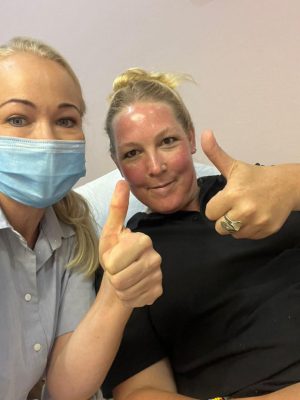
Who should do it?
“It’s suitable for all skin types across the age spectrum. Young skins can benefit from it by maintaining their dewy appearance and minimizing pore size, while mature skins can use it to induce collagen and turn back the clock a little by reducing the signs of aging.”
Who shouldn’t?
“Anyone with active inflammatory skin conditions such as psoriasis or nodular cystic acne might want to get these under control before having a treatment. Also, if you’re pregnant, have abnormal platelet function, are undergoing chemotherapy treatments, have acute and chronic infections or chronic liver disease, then it’s not advisable.”
And of course the big question that everyone wants to know the answer to?
How much does it cost? It’ll set you back about R2800, but after the results I’ve already seen, I’m sold that it is worth it …or at least tried, if only once. Mirror, mirror on the wall.
Details: Follow Dr Gwen on IG: drgwen_e or make a booking on WhatsApp 063 672 5918.

